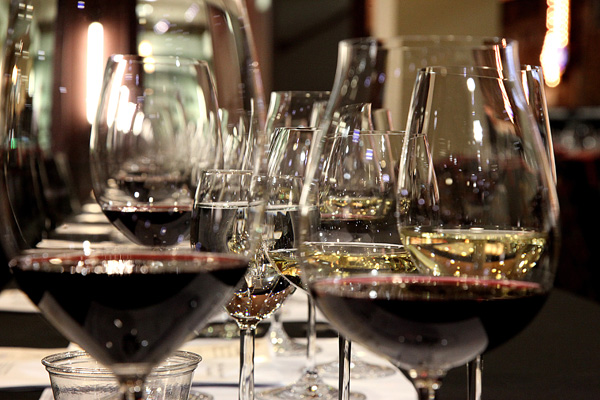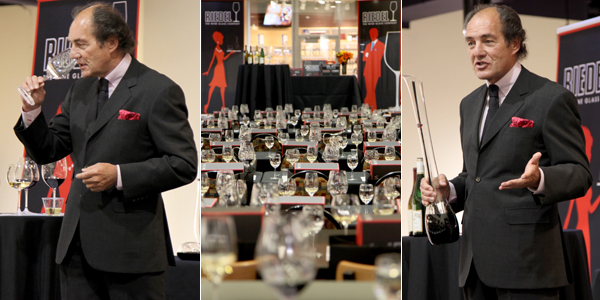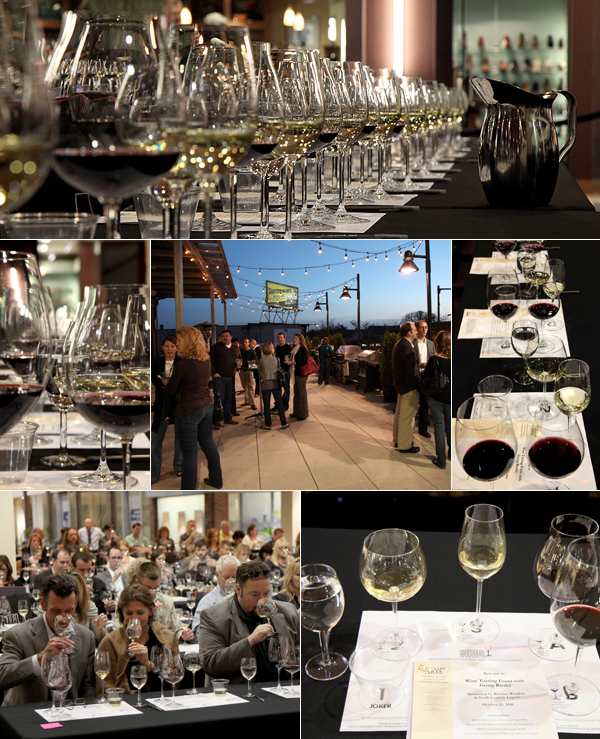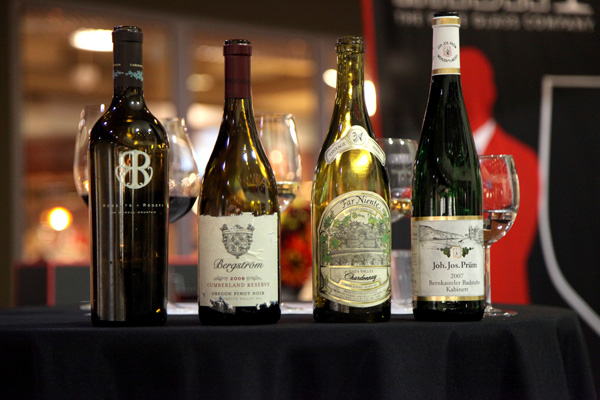
Glassmaker Georg Riedel has four pieces of advice for getting more enjoyment out of your wine drinking experience. 1) Enjoy the company of the people you’re drinking with. 2) Control the temperature. He recommends red wines be served slightly chilled, to about 65° F. This allows the wine to open up in the glass as it warms – the aromas shift, the flavors change, the wine is allowed time to show off its complexity. 3) Decant and aerate young red wines. 4) Use varietal-specific stemware. For most wine drinkers, points 1 through 3 make immediate sense. Riedel would soon sway the crowd on point 4.

“How much money do you spend on wine a year?” asked Riedel to the 100+ participants in last Friday night’s Kitchen Window seminar. “$20 a week? So conservatively, $1000. Now, how much did you spend on stemware? Zero. Right?” Basically, we’re taking the act of consumption for granted. Riedel (above) spoke of drinking as the second most innate reflex to humanity behind breathing. So why should need different glasses to help guide such an automated process? Riedel is the industry benchmark in the stemware industry for a reason. His demonstration proved that a little thoughtful consideration about drinking is very much worth it.
Riedel himself selected the wines from South Lyndale Liquors to show off the nuances of the four glasses in his Vinum XL tasting set. Appetizers for the evening were prepared by the Kitchen Window staff under the direction of their executive chef Dan Darvell, formerly of La Belle Vie.

Riedel likened crafting stemware to an architect designing a building, and with his glasses, form clearly follows function. His varietal-specific stemware is first crafted to show off the wine’s aroma, since most of your sense of taste is really your sense of smell. “You are smelling the head space in the glass,” Riedel explained. “In the wrong glass, wine loses its sex appeal, its character.” Riedel’s designs are such that they vary the angle at which your neck must tilt to receive the wine, thus introducing it onto a different part of your palate. How dramatically this creates a different mouthfeel among different varietals is shocking.
The Far Niente Chardonnay displayed this difference most prominently. It’s a big Napa Chardonnay – creamy and toasty with soft fruit. In the Montrachet glass, with its deep rounded bowl and wide mouth, it was balanced, mellow, and delicious. Transferred to the Riesling glass, with its short, compacted bowl and narrow mouth, it turned lean, austere, and pallid. Conversely, the J.J. Prum Riesling’s wonderful fruit flavors were subdued in the Montrachet glass and the acidity was most noticeable, leaving it tasting unbalanced. One gets to wondering how a lack of focused stemware could have caused many wines to fall short of their full potential.
“These vessels are tools,” says Riedel. It may seem inconsequential for glasses, but there’s something to be said for having the right tools in the kitchen. Anyone who’s tried to slice a loaf of warm bread with a non-serrated knife knows that some tools just work better with some foods. Riedel, in the true European fashion, urged us to think of wine as food and to treat it with the same care. By the end of the seminar, this author was a believer.

The evening’s wines included:
2008 Far Niente Estate Chardonnay, Napa Valley
2007 J.J. Prum Bernkasteler Badstube Riesling Kabinett
2005 Bertrand Ambroise Bourgogne Rouge
2005 Roberts and Rogers Howell Mountain Cabernet Sauvignon, Napa Valley
As participants in the Kitchen Window seminar, both the author and photographer of this story received a four-pack of Riedel Vinum XL glasses valued at $123.

I’m sold. My next purchase will be a Georg Riedel Riesling glass. Love the article.
nice job, JG. love seeing your articles on here!
Nice article. Great pictures.